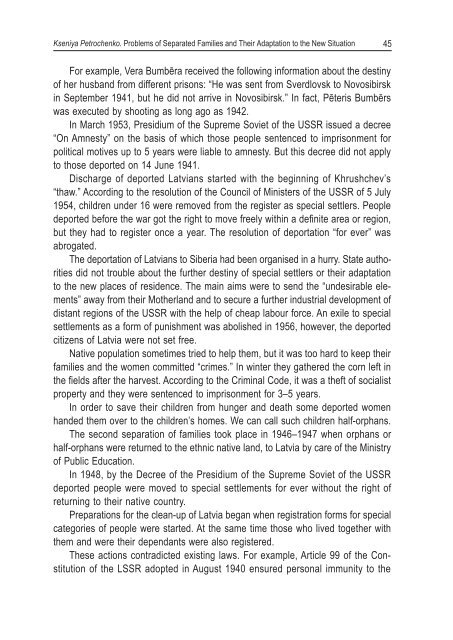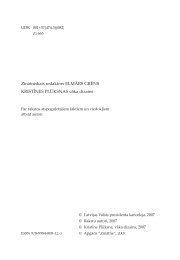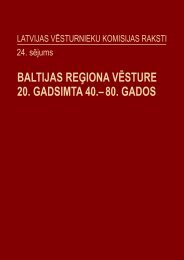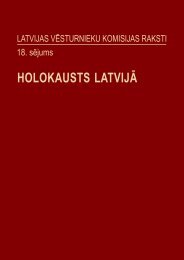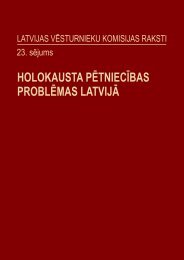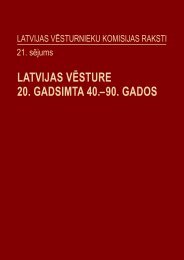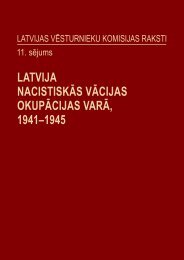15.sējums - Valsts prezidenta kanceleja
15.sējums - Valsts prezidenta kanceleja
15.sējums - Valsts prezidenta kanceleja
You also want an ePaper? Increase the reach of your titles
YUMPU automatically turns print PDFs into web optimized ePapers that Google loves.
Kseniya Petrochenko. Problems of Separated Families and Their Adaptation to the New Situation<br />
For example, Vera Bumbēra received the following information about the destiny<br />
of her husband from different prisons: “He was sent from Sverdlovsk to Novosibirsk<br />
in September 1941, but he did not arrive in Novosibirsk.” In fact, Pēteris Bumbērs<br />
was executed by shooting as long ago as 1942.<br />
In March 1953, Presidium of the Supreme Soviet of the USSR issued a decree<br />
“On Amnesty” on the basis of which those people sentenced to imprisonment for<br />
political motives up to 5 years were liable to amnesty. But this decree did not apply<br />
to those deported on 14 June 1941.<br />
Discharge of deported Latvians started with the beginning of Khrushchev’s<br />
“thaw.” According to the resolution of the Council of Ministers of the USSR of 5 July<br />
1954, children under 16 were removed from the register as special settlers. People<br />
deported before the war got the right to move freely within a definite area or region,<br />
but they had to register once a year. The resolution of deportation “for ever” was<br />
abrogated.<br />
The deportation of Latvians to Siberia had been organised in a hurry. State authorities<br />
did not trouble about the further destiny of special settlers or their adaptation<br />
to the new places of residence. The main aims were to send the “undesirable elements”<br />
away from their Motherland and to secure a further industrial development of<br />
distant regions of the USSR with the help of cheap labour force. An exile to special<br />
settlements as a form of punishment was abolished in 1956, however, the deported<br />
citizens of Latvia were not set free.<br />
Native population sometimes tried to help them, but it was too hard to keep their<br />
families and the women committed “crimes.” In winter they gathered the corn left in<br />
the fields after the harvest. According to the Criminal Code, it was a theft of socialist<br />
property and they were sentenced to imprisonment for 3–5 years.<br />
In order to save their children from hunger and death some deported women<br />
handed them over to the children’s homes. We can call such children half-orphans.<br />
The second separation of families took place in 1946–1947 when orphans or<br />
half-orphans were returned to the ethnic native land, to Latvia by care of the Ministry<br />
of Public Education.<br />
In 1948, by the Decree of the Presidium of the Supreme Soviet of the USSR<br />
deported people were moved to special settlements for ever without the right of<br />
returning to their native country.<br />
Preparations for the clean-up of Latvia began when registration forms for special<br />
categories of people were started. At the same time those who lived together with<br />
them and were their dependants were also registered.<br />
These actions contradicted existing laws. For example, Article 99 of the Constitution<br />
of the LSSR adopted in August 1940 ensured personal immunity to the<br />
45


